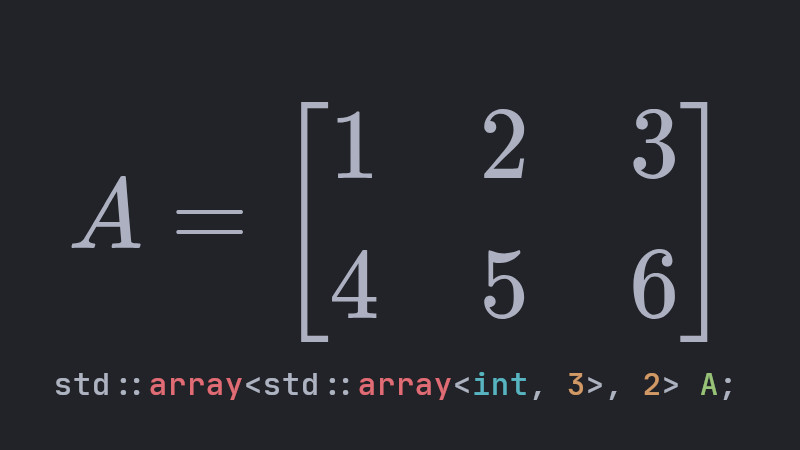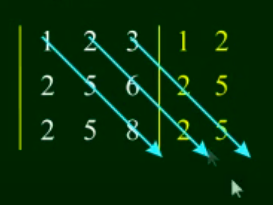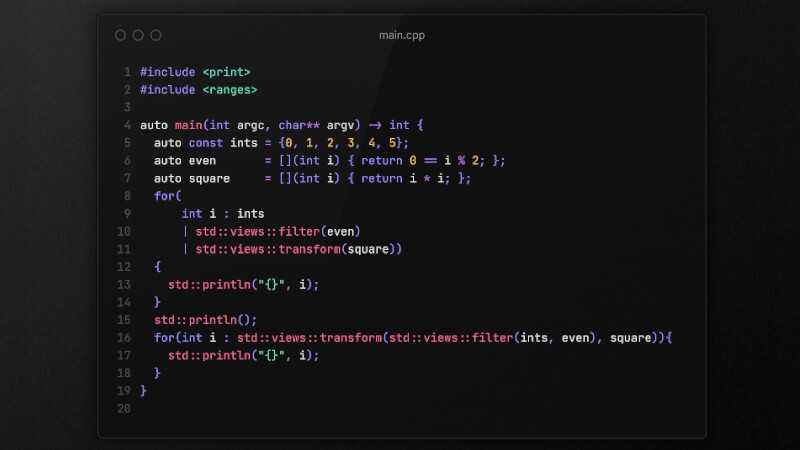
In this article, we’ll revisit fundamental concepts about Matrices and Determinants.
Matrix
A quick explanation: a matrix organizes numeric data (like a table) to facilitate understanding and solving problems.
Matrices are used in various fields:
- Mathematics;
- Computing (AI, image processing…);
- Engineering;
- Economics;
- Biology;
Among many others.
In general: A matrix is a rectangular array of numbers (or expressions) arranged in rows and columns. It looks like this:

This matrix has an order of 2x3 (2 rows and 3 columns). We always start by indicating the number of rows.
The notation A = [aij]<sub>mxn</sub> means, for example:
- The number
1is in the 1st row and 1st column →a11, and so on.
Converted entirely into aij:

In C++, we can use std::vector or std::array:
- Use
std::vector<std::vector<int>>for dynamic and flexible size. - Use
std::array<std::array<int, 3>, 2>for fixed size known at compile time. Never usestd::listfor matrices. It has inefficient random access.
Examples:
Using std::vector:
std::vector<std::vector<int>> A = {
{1, 2, 3},
{4, 5, 6}
};Using std::array:
std::array<std::array<int, 3>, 2> A = { {
{1, 2, 3},
{4, 5, 6}
} };Which to use?
- Use
std::vectorif the size changes at runtime. - Use
std::arrayfor maximum performance with fixed size.
Matrix construction
Suppose you’re taking an exam and see this prompt:
- Build matrix B = [
aij]2x3 such thataij = (i + j)2.
Solution:
aij = (i + j)2 ⇒a11 = (0 + 0)2 ⇒a11 = 0Do the rest accordingly
In C++, using std::array:
#include <array>
#include <iostream>
int main() {
std::array<std::array<int, 3>, 2> B;
for (int i = 0; i < 2; ++i) {
for (int j = 0; j < 3; ++j) {
B[i][j] = (i + j) * (i + j);
}
}
for (const auto& row : B) {
for (int val : row) {
std::cout << val << " ";
}
std::cout << "\n";
}
return 0;
}With std::vector, just replace:
std::vector<std::vector<int>> B(2, std::vector<int>(3));The rest is the same.
The result:

Matrix Types
Segue a tradução:
1. Square Matrix
- Description: Number of rows equals number of columns (
nxn). - Example:

2. Row Matrix
- Description: Only one row.
- Example:

3. Column Matrix
- Description: Only one column.
- Example:

4. Zero Matrix
- Description: All elements are zero.
- Example:

5. Identity Matrix
- Description: Main diagonal has 1s, rest are 0s. Denoted by In.
- Example:

6. Diagonal Matrix
- Description: Only the main diagonal can have nonzero values.
- Example:

7. Scalar Matrix
- Description: Diagonal matrix where all diagonal values are equal.
- Example:

8. Symmetric Matrix
- Description: A = AT, i.e., equal to its transpose.
- Example:

9. Skew-Symmetric Matrix
- Description: AT = -A. Main diagonal is always zero.
- Example:

10. Upper Triangular Matrix
- Description: All elements below the main diagonal are zero.
- Example:

11. Lower Triangular Matrix
- Description: All elements above the main diagonal are zero.
- Example:

12. Transpose Matrix
- Description: Rows become columns. Denoted AT.
- Example:

13. Opposite Matrix
- Description: All elements multiplied by -1.
- Example:

14. Rectangular Matrix
- Description: Number of rows is different from number of columns.
- Example:

Matrix Calculations
Arithmetic (algebraic or matrix) operations with matrices.
a) Addition and Subtraction
Only possible if matrices have the same order.

That is,
1 + 5=6,2 + 6=8, and so on.
In C++:
#include <array>
#include <iostream>
int main() {
std::array<std::array<int, 2>, 2> A = { { {1, 2}, {3, 4} } };
std::array<std::array<int, 2>, 2> B = { { {5, 6}, {7, 8} } };
std::array<std::array<int, 2>, 2> C;
for (int i = 0; i < 2; ++i){
for (int j = 0; j < 2; ++j){
C[i][j] = A[i][j] + B[i][j];
}
}
for (auto& row : C){
for (int v : row){
std::cout << v << (v == row.back() ? '\n' : ' ');
}
}
}
b) Scalar Multiplication
Each element is multiplied by a real number (scalar).

That is,
3 x 1=3,3 x 2=6, and so on.
In C++:
#include <array>
#include <iostream>
int main() {
std::array<std::array<int, 2>, 2> A = { { {1, 2}, {3, 4} } };
std::array<std::array<int, 2>, 2> B;
int scalar = 3;
for (int i = 0; i < 2; ++i){
for (int j = 0; j < 2; ++j){
B[i][j] = scalar * A[i][j];
}
}
for (auto& row : B){
for (int v : row){
std::cout << v << (v == row.back() ? '\n' : ' ');
}
}
}
c) Matrix Multiplication
The number of columns of the first matrix must equal the number of rows of the second.

In C++:
#include <array>
#include <iostream>
int main() {
std::array<std::array<int, 2>, 2> A = { { {1, 2}, {3, 4} } };
std::array<std::array<int, 2>, 2> B = { { {5, 6}, {7, 8} } };
std::array<std::array<int, 2>, 2> C = {};
for (int i = 0; i < 2; ++i){
for (int j = 0; j < 2; ++j){
for (int k = 0; k < 2; ++k){
C[i][j] += A[i][k] * B[k][j];
}
}
}
for (auto& row : C){
for (int v : row){
std::cout << v << (v == row.back() ? '\n' : ' ');
}
}
}
Determinants
A determinant is a number associated only with square matrices, useful to solve linear systems and verify if a matrix is invertible.
IMPORTANT: Matrices are denoted with brackets
[ ], but determinants use vertical bars| |.
3.2 Calculating the Determinant
a) 2x2 Matrix

Example:

Em C++:
#include <iostream>
int main(){
int a = 1, b = 2;
int c = 3, d = 4;
int det = a * d - b * c;
std::cout << det << '\n';
}b) 3x3 Matrix (Sarrus Rule)
Sarrus’ Rule consists of appending the 1st and 2nd columns to the right side of the determinant matrix and drawing diagonals (starting from the numbers in the first ROW), for example:
This is for a
3x3matrix.


Example:

= 45 + 84 + 96 - 105 - 48 - 72 = 0
In C++:
#include <iostream>
int main(){
int a11 = 1, a12 = 2, a13 = 3;
int a21 = 4, a22 = 5, a23 = 6;
int a31 = 7, a32 = 8, a33 = 9;
int det =
a11 \* a22 \* a33 +
a12 \* a23 \* a31 +
a13 \* a21 \* a32
\- a13 \* a22 \* a31
\- a11 \* a23 \* a32
\- a12 \* a21 \* a33;
std::cout << det << '\n';
}3.3 Properties of Determinants
- If a row or column is all zeros,
det = 0. - If two rows or columns are equal,
det = 0. det(A x B) = det(A) x det(B).
4. Applications
- Linear Systems: Solve using Cramer’s Rule.
- Inverse Matrix: A matrix A is invertible if det(A) ≠ 0.
5. Exercise
- Compute the determinant:

Em C++:
#include <iostream>
int main(){
int a = 7, b = 3;
int c = -2, d = 4;
int det = a * d - b * c;
std::cout << det << '\n';
}
Answer: 14.




